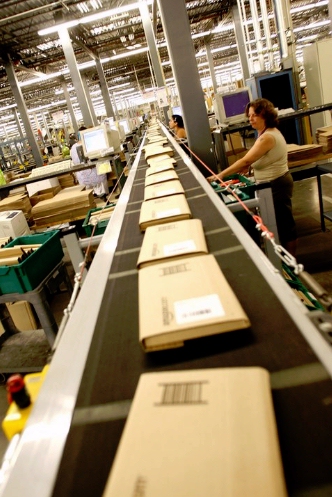
Nearly 1 out of every 8 adults in America now owns a Kindle or another digital reading device! And what’s even more amazing — that’s twice as many as there were just six months ago, in November of 2010!
That’s the conclusion of a new study from the Pew Research Center — which is significant, because it’s a research firm that I’ve actually heard of. (They’re a Washington D.C. think tank, and they’re credited as sponsors on some public radio programs.) Looking at the population of U.S. adults, “This is the first time since the Pew Internet Project began measuring e-reader use in April 2009 that ownership of this device has reached double digits,” the group’s associate director announced in a statement. And what’s even more interesting is according to this study, Americans are buying digital readers much faster than they’re buying tablet-sized computers like the iPad!
“Tablet computers …have not seen the same level of growth in recent months,” writes Kristen Purcell in today’s announcement. While 12% of U.S. adults have a digital reader, just 8% of them own a tablet, according to the study — and it suggests the popularity of tablets might have reached a plateau. In January, 7% of U.S. adults already owned a tablet computer, so very little has changed over the last four months, and even back in November, 5% of U.S. adults had already bought a tablet. Over the next five months, tablet ownership increased from 5% to only to 8% — while digital readers jumped from 6% to 12%. “Prior to that, tablet ownership had been climbing relatively quickly,” the study notes — but apparently now only the Kindle (and other digital readers) are attracting lots of customers in the U.S.
There’s a little overlap between the two groups. 3% of America’s adults own both a tablet and a digital reader, according to the study. (And of the remainder, there’s 5% who own just a tablet, while there’s 9% who own just a digital reader.) Of course, 83% of American adults don’t own either device — which means there’s still potential for a lot of new Kindle (and tablet) owners in the years ahead. And another interesting statistic points in the same direction.
“[T]his survey marks the first time that laptop computers are as popular as desktop computers among U.S. adults…” writes Purcell, “further confirming the overall trend toward adoption of mobile devices.” Last November there were more Americans who owned a desktop computer (61%) than who owned a laptop (53%) — but now, an equal number of Americans reported owning each kind of device — around 57%. Plus, among younger Americans (under the age of 30), “laptops have already overtaken desktops in popularity…” the study reports, noting that laptops now also “appear poised to do the same among older adults.”
So who’s buying a Kindle or another digital reader? In the last six months, there’s been a huge jump in the number of American college graduates — from 8% to 22%. And reader ownership has doubled in the last six months for adults living in a household earning more than $75,000 a year, to 24% — which is almost double the ownership rates for households earning between $30,000 and $75,000 a year (now at 13%). But the study also found some other groups of people who were also very likely to own a reader.
- Adults younger than age 65 (37%)
- Parents of children under the age of eighteen (16%)
- Hispanic adults (15%)
I’m stumped on how to explain those demographic trends. Some suggest the Kindle and other readers have been adopted by more mainstream middle-aged consumers over the last six months. (“[O]wnership among adults ages 18-49 grew more rapidly than any other age group,” the study reports — from 11% to 24%.) But the study’s other data seems strangely specific — for example, that “in the past six months ownership of these devices among parents [now 16%] has grown more rapidly than it has among non-parents [now 10%].” And the study’s data is even more striking for Hispanic owners of Kindles and other digital reading devices. “E-reader ownership grew at a faster pace among Hispanic adults over that time period [from 5% to 15%] than it did among white adults [6% to 11%] or African-American adults [from 5% to 8%].”
There’s one other interesting statistic. In November, men and women were equally likely to own a digital reader, but by May, there were slightly more men. 11% of the women in America now own a reader (according to the study), compared to 12% of the men. But it’s even more interesting that just six months ago, only 6% of men and women owned a digital reader.
I want to believe this all means something — that e-books are now achieving a special “critical mass”. We’re past the “early adopter” stage, when digital readers seemed like exotic but expensive luxury items that only a geek would buy. Now a significant share of Americans owns a digital reader, and the size of that share has doubled in just six months. Soon nearly everyone will own a Kindle (or a Nook) — and we’ll all be reading ebooks instead of printed books.
There’s always been changes happening in the world, but it’s usually hidden somewhere beyond our own day-to-day life. So it’s very exciting when you can see the signs of a big change…while it’s still happening!